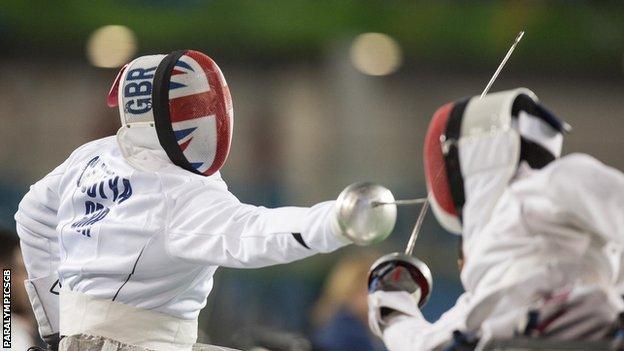Wheelchair fencing at Tokyo Paralympics: All you need to know
- Published

Dimitri Coutya missed out on a medal for GB in Rio but will be challenging for gold this time around
Paralympic Games on the BBC |
|---|
Venue: Tokyo, Japan Dates: 24 August-5 September Time in Tokyo: BST +8 |
Coverage: Follow on Radio 5 Live and on the BBC Sport website |
Key information
Dates: 25-29 August
Venue: Makuhari Messe Hall B
Gold medals on offer: 16
How does it work?
There are three disciplines in wheelchair fencing based on the type of sword used - the foil, the epee and the sabre.
The epee is the heaviest weapon at 770g and is more rigid than the other swords, the foil is lighter and highly flexible while the sabre has a short, flexible blade.
In the foil event, fencers are only permitted to strike the trunk area of the opponent, while in the sabre and epee, anywhere above the waist is a valid target area.
Fencers record hits by striking their opponent cleanly in the valid area, with successful hits recorded by the electronic equipment.
During a contest, the fencers' wheelchairs are fastened into metal frames on the floor at an angle of 110 degrees. This allows freedom of the upper body only and allows the fencers' sword arms to oppose each other. The distance between the fencers is dependent on the fighter with the shorter arm reach.
Bouts last a maximum of three minutes in the preliminary pool stages of the competition, with victory going to the first fencer to score five valid hits or the one with the most hits at the end of the three minutes.
The preliminary round results form the seedings for the knockout stages. Here, bouts consist of three rounds of three minutes. The winner is the first to score 15 hits, or the highest scorer at the completion of the contest. In the event of a tie, an extra one-minute sudden death bout is held, with the first person to score a valid hit taking the contest.
In team events, teams are made up of three fencers. Each fencer faces each opponent in the other team in a single bout of three minutes. The winning team is the team with the most points when the time is up, or the first to reach a cumulative score of 45 points.
Classification divisions are based on impairment. Category A fencers have good trunk control, whereas Category B athletes have an impairment that impacts their trunk or their fencing arm.
Who are the British medal hopes?
Piers Gilliver became the first British wheelchair fencer to win a Paralympic medal for 24 years when he took silver in the epee A event in Rio and he is also a strong contender in the sabre A event. Dimitri Coutya lost out in the last eight of his competition five years ago but has improved since then and is the current epee B world champion and foil B silver medallist.
Who are the other medal challengers?
China have been the dominant nation in recent times, topping the medal table at the 2016 Paralympics and also at the 2019 World Championships. Among their stars is Shumei Tan who won two golds at the last Worlds and who will be looking to win gold in the women's sabre B event as it makes its Games debut.
Did you know?
Italy's Beatrice Vio, who won foil B gold in Rio, is one of the stars of the sport and featured in the Netflix documentary Rising Phoenix. She contracted meningitis aged 11 and needed to have both her legs amputated below the knee and both her arms amputated from the forearms but she fences with the aid of a special prosthesis.
ParalympicsGB Rio 2016 medals
One silver (Piers Gilliver)